The cars are equipped with a steering gear with a gear-rack type steering mechanism equipped with an electric amplifier and a safety steering column, adjustable in tilt and reach
The steering gear consists of two steering rods and two of their tips connected by ball joints to the levers of the steering knuckles of the front suspension.
The control unit in the electric power steering system is the Electronic Power Steering (EPS) control unit
Based on information from steering column-mounted sensors and engine and ABS electronic control units, the electric power steering control unit activates the gearmotor on the steering gear to generate additional torque
The electric power steering system, along with the electronic control unit, includes sensors, actuators, connectors and fuses.
Electronic control unit (ECU)
The electronic control unit (ECU) for the electric power steering (EPS) system is installed in the engine compartment under the brake master cylinder
The electronic control unit is connected by electrical wires to all sensors of the system
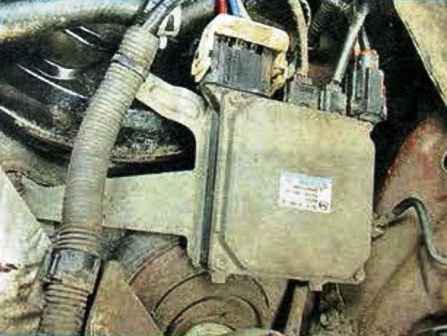
The electric power steering control unit determines the direction and value of the additional effort depending on the vehicle speed and signals from the torque sensor mounted on the steering column shaft
As a result, the electric power steering ECU adjusts the amount of steering effort depending on the vehicle speed: the lower the vehicle speed, the greater the amount of effort; on the contrary, at high speeds, the effort on the steering wheel is minimal
This characteristic of the electric power steering provides ease of maneuvering when driving at low speeds and a sense of feedback on the steering wheel when driving at relatively high speeds.
Rotor speed sensor mounted on steering box
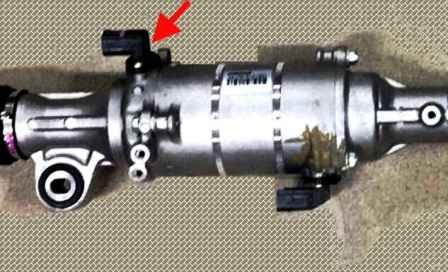
The sensor determines the value of the angle of twist of the torsion shaft and converts it into an electrical signal supplied to the ECU of the electric power steering system
Torque sensor mounted on steering gear shank

The sensor converts the steering angle value into an electrical signal that is sent to the electric power steering ECU.
The steering wheel angle sensor is mounted on the steering column between the steering column switches and the steering wheel (under the airbag return and sliding rings)
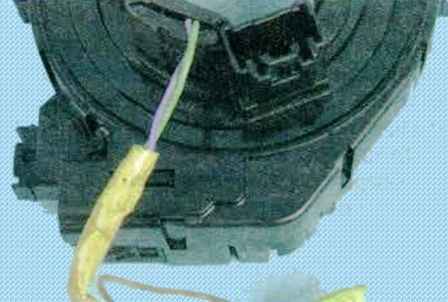
An electronic engine control unit installed in the engine compartment transmits engine speed data to the ECU of the electric power steering system.
The ABS hydro-electronic module, located in the engine compartment, transmits vehicle speed data to the electric power steering system control unit.
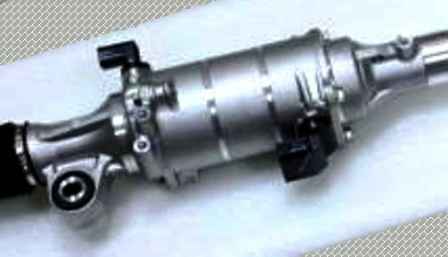
The electric power steering gear motor generates additional torque when it is energized by signals from the electric power steering system control unit.
Steering wheel with driver's airbag
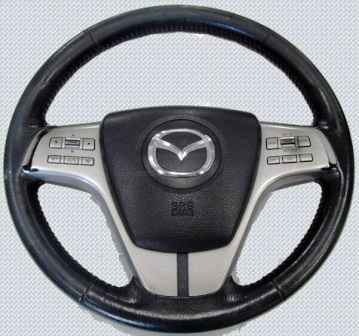
The horn switch is located in the center pad of the steering wheel
Steering wheel hub attached ena bolt to the steering column shaft.
The steering mechanism is installed in the engine compartment and secured with three bolts to the front suspension subframe.

Tie rods are attached to the steering rack 7 (see Fig. 7) with ball joints
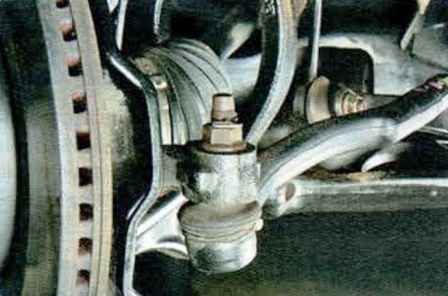
Tie rod ends 2 are attached to the steering knuckles of the front suspension using ball joints 1
To prevent turning on the steering rods, the tips are fixed with lock nuts 3.
By rotating the steering rod in the ball joint relative to the tip, the toe-in of the front wheels is adjusted.
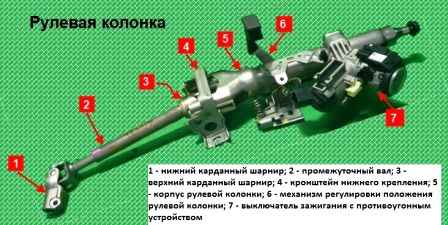
The steering column is safety, with a mechanism 6 (Fig. 9) for adjusting the position of the steering wheel, equipped with energy-absorbing devices (intermediate shaft) 2, which increase passive safety, and an anti-theft device in the ignition lock 7, which blocks the steering wheel shaft from turning.
Checking the steering on the car
Regularly check the condition of the steering, as driving safety depends on it.
When inspecting the steering, pay special attention to the condition of the protective covers and threaded connections.
Be sure to replace rubber boots that are torn, cracked or have lost elasticity, otherwise water, dust and dirt that get into the nodes will quickly disable them.
Check the position of the steering wheel spokes, which, when the front wheels are in a straight line, should be located symmetrically about the vertical axis
If not, determine the cause of the problem and fix it.
Turning the steering wheel from lock to lock, check visually and aurally:
- - reliability of fastening of the steering mechanism and steering wheel;
- - lack of clearance in the tie rod bushings and ball joints of the tie rod ends;
- - the reliability of tightening and locking the bolts for fastening the rods to the rail and the nuts of the fingers of the ball joints;
- - lack of jamming and interference preventing the steering wheel from turning.
If you find rattling or binding, disconnect the tie rods from the strut pivot arms and retest.
If the knocking and binding continues, remove the steering gear from the vehicle and have it repaired.
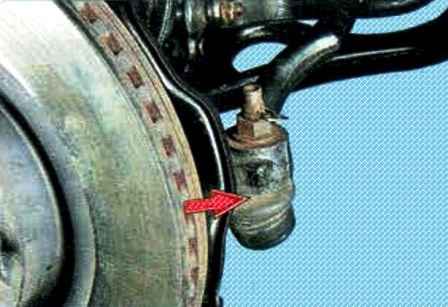
Check the condition of the protective covers of the tie rod ends.
Replace any torn, cracked, or loose covers.
By turning the steering wheel sharply in both directions (this should be done by an assistant), visually and aurally check the steering gear mounting.
Movement of the mechanism and knocks are not allowed.

Check for play in the ball joints of the tie rod ends.
Replace the tips, the hinges of which have a noticeable play
Also check the tightness of the ball joint pin nuts of the tie rod ends
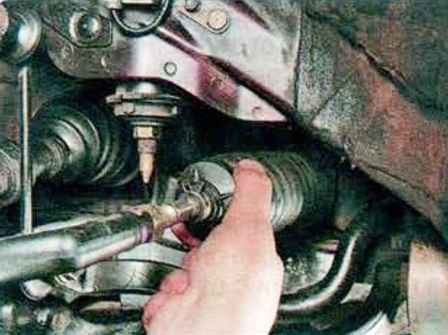
Check the condition of the protective covers of the steering rods. Be sure to replace damaged covers.
Checking the free play (backlash) of the steering wheel
With an increased free play of the steering wheel, it is difficult to control the car, as it responds to the driver's actions with a delay
In addition, an increased stroke that cannot be eliminated by adjusting the steering mechanism indicates a steering malfunction (loosening of the steering mechanism, steering rods or wear of their parts).
Check the steering wheel play with the vehicle parked on a level, non-slip surface. The play should not exceed 5º.
You can also determine the backlash in linear units (mm) using the formula L = (5º/360º)πD, where L is the steering wheel backlash, mm; pi = 3.14; D - outer diameter of the steering wheel, mm.
For example, for a steering wheel with an outer diameter of 370 mm, the play should not be more than 14-16 mm.
You will need: a ruler (rail), chalk or wire (insulating tape) for marking, calipers.
Set the front wheels in a straight ahead position.

Install the ruler (rail) so that its end rests against the instrument panel, and the plane of the ruler touches the outer surface of the steering wheel rim.

Without changing the position of the ruler, turn the steering wheel to the left until the front wheels begin to turn.
In this position, mark the steering wheel rim (attach wire or tape).
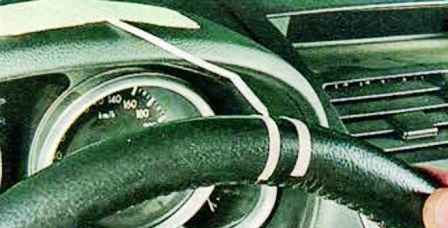
Without changing the position of the ruler, turn the steering wheel to the right until the front wheels begin to turn.
In this position, make a second mark on the steering wheel rim (fix the wire or tape).

Measure the distance between the marks along the rim.
It should not exceed the calculated value.
If the distance (steering wheel free play) is greater, the cause must be determined and corrected.
Possible steering problems and solutions
Increased steering wheel play
- loosening the nuts of the ball pins of the rods
Tighten the nuts
- increased clearance in the ball joints of the rods
Replace rod ends
- increased clearance between the rail stop and the nut
Replace worn parts and adjust steering
Noise (knocking) in the steering
- Loosening the nuts of the ball joints of the rods
Check and tighten nuts
- increased clearance between the rail stop and the nut
Replace worn parts and adjust steering
- loosening of the steering mechanism
Tighten the steering gear nuts
Steering wheel tight
- damage to the bearing of the upper support of the suspension strut
Replace bearing or support assembly
- damage to the support sleeve or rail stop
Replace damaged parts, apply lubricant
- low pressure in the tires of the front wheels
Set your tires to the correct pressure
- damage to the parts of the ball joints of the rods
Replace damaged parts
- faulty electric power steering
Replace the electric power steering assembly





